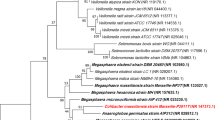Abstract
Ten strains of the nalidixic acid-resistant thermophilicCampylobacter (NARTC) group, of which 2 were isolated from human feces, were compared with 12 reference strains representing various species ofCampylobacter. The NARTC strains were a homogeneous group with respect to their cell morphology and 28 physiological and biochemical characters. All were microaerophilic, motile (amphitrichate), gram-negative, curved, S-shaped or helical rods, and representative strains had mean DNA base compositions of 31 to 32 mol % G+C. Distinctive features of the 10 strains were resistance to nalidixic acid and anaerobic growth in the presence of trimethylamine N-oxide hydrochloride (TMAO). The latter feature may account for the common occurrence of NARTC strains in the fecal contents of seagulls. DNA-DNA hybridizations indicated high (≥76%) base sequence relatedness within the group and low (≤15%) relatedness to other species ofCampylobacter. The 10 strains were classified in the genusCampylobacter but they could not be assigned to any previously defined species. Therefore, a new species, with the nameCampylobacter laridis, is proposed for these 10 strains; the type strain is NCTC 11352.
Similar content being viewed by others
Literature Cited
Belland, R. J., Trust, T. J. 1982. Deoxyribonucleic acid sequence relatedness between thermophilic members of the genusCampylobacter. Journal of General Microbiology128:2515–2522.
Blaser, M. J., Moss, C. W., Weaver, R. E. 1980. Cellular fatty acid composition ofCampylobacter fetus. Journal of Clinical Microbiology11:448–451.
Burman, L. G. 1977. Apparent absence of transferable resistance to nalidixic acid in pathogenic gram-negative bacteria. Journal of Antimicrobial Chemotherapy3:509–516.
Cook, G. T. 1950. A plate test for nitrate reduction. Journal of Clinical Pathology3:359.
Cowan, S. T. 1974. Cowan and Steel's manual for the identification of medical bacteria. Cambridge: University Press.
Curtis, M. A. 1982. Cellular fatty acid profiles of campylobacters, pp. 234–241. In: D. G. Newell (ed.)Campylobacter, epidemiology, pathogenesis and biochemistry. Lancaster: MTP Press Ltd.
Garrod, L. P., Lambert, H. P., O'Grady, F. 1981. Antibiotics and chemotherapy, 5th ed. Edinburgh: Churchill Livingstone.
Hugh, R., Leifson, E. 1953. The taxonomic significance of fermentative versus oxidative metabolism of carbohydrates by various gram-negative bacteria. Journal of Bacteriology66:24–26.
Karmali, M. A., Allen, A. K., Fleming, P. C. 1981. Differentiation of catalase-positive campylobacters with special reference to morphology. International Journal of Systematic Bacteriology31:64–71.
King, E. O. 1957. Human infections withVibrio fetus and a closely related vibrio. Journal of Infectious Diseases101:119–128.
Leaper, S., Owen, R. J. 1981. Identification of catalaseproducingCampylobacter species based on biochemical characteristics and on cellular fatty acid composition. Current Microbiology31:31–35.
Leaper, S., Owen, R. J. 1982. Differentiation betweenCampylobacter jejuni and allied campylobacters by hybridization of deoxyribonucleic acids. FEMS Microbiology Letters15:203–208.
Luechtefeld, N. W., Wang, W. L. L. 1982. Hippurate hydrolysis by and triphenyltetrazolium tolerance ofCampylobacter fetus. Journal of Clinical Microbiology15:137–140.
Owen, R. J., Leaper, S. 1981. Base composition, size and nucleotide sequence similarities of genome deoxyribonucleic acids from species of the genusCampylobacter. FEMS Microbiology Letters12:395–400.
Owen, R. J., Legros, R. M., Lapage, S. P. 1978. Base composition, size and sequence similarities of genome deoxyribonucleic acids from clinical isolates ofPseudomonas putrefaciens. Journal of General Microbiology104:127–138.
Razi, R. H. H., Park, R. W. A., Skirrow, M. B. 1981. Two new tests for differentiating between strains ofCampylobacter. Journal of Applied Bacteriology50:55–57.
Skerman, V. B. D., McGowan, V., Sneath, P. H. A. (ed.). 1980. Approved lists of bacterial names. International Journal of Systematic Bacteriology30:225–420.
Skirrow, M. B., Benjamin, J. 1980. Differentiation of enteropathogenicCampylobacter. Journal of Clinical Pathology33:1122.
Skirrow, M. B., Benjamin, J. 1980. “1001” campylobacters: cultural characteristics of intestinal campylobacters from man and animals. Journal of Hygiene (Cambridge)85:427–442.
Tanner, A. C. R., Badger, S., Lai, C.-H., Listgarten, M. A., Visconti, R. A., Socransky S. S. 1981.Wolinella gen. nov.,Wolinella succinogenes (Vibrio succinogenes Wolin et al.) comb. nov., and description ofBacteriodes gracilis sp. nov.,Wolinella recta sp. nov.,Campylobacter concisus sp. nov., andEikenella corrodens from humans with periodontal disease International Journal of Systematic Bacteriology31:432–445.
Taylor, D. E., De Grandis, S. A., Karmali, M. A., Fleming, P. C. 1982. Transmissible resistance inCampylobacter jejuni, pp. 207–210. In: D. G. Newell (ed.),Campylobacter, epidemiology, pathogenesis and biochemistry. Lancaster: MTP Press Ltd.
Véron, M., Chtelain R. 1973. Taxonomic study of the genusCampylobacter Sebald and Véron and designation of the neotype strain for the type speciesCampylobacter fetus (Smith and Taylor) Sebald and Véron. International Journal of Systematic Bacteriology23:122–134.
Author information
Authors and Affiliations
Rights and permissions
About this article
Cite this article
Benjamin, J., Leaper, S., Owen, R.J. et al. Description ofCampylobacter laridis, a new species comprising the nalidixic acid resistant thermophilicCampylobacter (NARTC) group. Current Microbiology 8, 231–238 (1983). https://doi.org/10.1007/BF01579552
Issue Date:
DOI: https://doi.org/10.1007/BF01579552




